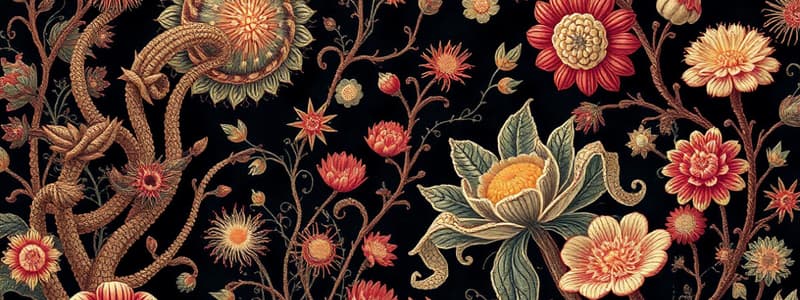Podcast
Questions and Answers
All protists are parasitic and cause harm to humans.
All protists are parasitic and cause harm to humans.
False (B)
Flagellates are a type of protist that only utilizes flagella for movement.
Flagellates are a type of protist that only utilizes flagella for movement.
False (B)
The classification of protists relies solely on traditional methods that examine physical characteristics.
The classification of protists relies solely on traditional methods that examine physical characteristics.
False (B)
Protists, such as Plasmodium, are responsible for causing diseases like giardiasis and African sleeping sickness.
Protists, such as Plasmodium, are responsible for causing diseases like giardiasis and African sleeping sickness.
Sporozoans are known to be free-living organisms, contributing to oxygen production in aquatic environments.
Sporozoans are known to be free-living organisms, contributing to oxygen production in aquatic environments.
All protists are unicellular.
All protists are unicellular.
Protists can only obtain energy through heterotrophy, consuming other organisms.
Protists can only obtain energy through heterotrophy, consuming other organisms.
All protists possess flagella for locomotion.
All protists possess flagella for locomotion.
Protists are a monophyletic group, meaning they share a single common ancestor.
Protists are a monophyletic group, meaning they share a single common ancestor.
All protists exist in aquatic environments.
All protists exist in aquatic environments.
Diatoms are a type of protozoa, contributing to the decomposition of organic matter.
Diatoms are a type of protozoa, contributing to the decomposition of organic matter.
Harmful algal blooms (HABs) are exclusively caused by diatoms, posing a significant threat to marine ecosystems.
Harmful algal blooms (HABs) are exclusively caused by diatoms, posing a significant threat to marine ecosystems.
Ciliates, a type of protozoa, are distinguished by their complex cellular structures, including a macronucleus and micronucleus.
Ciliates, a type of protozoa, are distinguished by their complex cellular structures, including a macronucleus and micronucleus.
Flashcards
Sporozoans
Sporozoans
Parasitic protists with complex life cycles affecting hosts.
Flagellates
Flagellates
Protists that move using flagella; can be free-living or parasitic.
Protists and Disease
Protists and Disease
Certain protists cause diseases like malaria and giardiasis in humans.
Molecular Data in Classification
Molecular Data in Classification
Signup and view all the flashcards
Role in Ecosystems
Role in Ecosystems
Signup and view all the flashcards
Protists
Protists
Signup and view all the flashcards
Eukaryotic cells
Eukaryotic cells
Signup and view all the flashcards
Nutritional modes
Nutritional modes
Signup and view all the flashcards
Diatoms
Diatoms
Signup and view all the flashcards
Dinoflagellates
Dinoflagellates
Signup and view all the flashcards
Amoebas
Amoebas
Signup and view all the flashcards
Ciliates
Ciliates
Signup and view all the flashcards
Multicellular protists
Multicellular protists
Signup and view all the flashcards
Study Notes
Protists: A Diverse Group
- Protists are a diverse group of eukaryotic organisms that are not plants, animals, or fungi.
- They exhibit varied characteristics and lifestyles, including photosynthesis, predation, and absorption.
- They are typically unicellular, but some are multicellular.
- They inhabit diverse aquatic and moist terrestrial environments.
Key Characteristics of Protists
- Eukaryotic cells, possessing a nucleus and membrane-bound organelles.
- Diverse nutritional modes: autotrophic (photosynthetic), heterotrophic (consuming other organisms), or mixotrophic (both).
- Varying cell structures: some have flagella, cilia, or pseudopodia for movement.
- Complex life cycles, often with intricate stages of sexual and asexual reproduction.
Classification Challenges
- Protists are not a monophyletic group, arising from different evolutionary lineages.
- Traditional classifications are outdated, frequently based on superficial similarities rather than evolutionary relationships.
- Molecular data, like DNA sequencing, is now crucial for accurate modern classifications.
Importance of Protists
- Primary Producers: Photosynthetic protists (like phytoplankton) are vital for aquatic life, forming the base of the food web and influencing oxygen levels.
- Decomposition: Some protists are saprophytes, aiding in decomposition and nutrient cycling.
- Symbiotic Relationships: Certain protists engage in symbiotic relationships with other organisms, such as corals or animals.
Major Groups of Protists
- Algae: Photosynthetic protists including diatoms, dinoflagellates, and green algae.
- Diatoms: Unicellular algae with silica shells, crucial for oxygen production and aquatic ecosystems.
- Dinoflagellates: Unicellular algae with two flagella, abundant in marine environments; some species cause harmful algal blooms (HABs).
- Green algae: Diverse forms, both unicellular and multicellular, closely related to land plants.
- Protozoa: Heterotrophic protists including amoebas, paramecia, and ciliates.
- Amoebas: Move using pseudopodia; some are free-living, others are parasitic.
- Ciliates: Move using cilia, characterized by complex cellular structures like macronuclei and micronuclei.
- Sporozoans: Primarily parasitic, often with complex life cycles.
- Flagellates: Move via flagella; some are free-living, others are parasitic.
- Slime molds: Unusual protists exhibiting fungal and amoeboid characteristics, either plasmodial or cellular.
Protists and Human Health
- Some protists are parasitic, causing diseases like malaria (caused by Plasmodium), giardiasis, and African sleeping sickness.
- Others are beneficial, contributing to oxygen production and being used in research.
Evolutionary Relationships
- Current research using molecular data analysis is elucidating the evolutionary relationships between various protist groups, creating a more modern and robust phylogeny.
Importance in Ecosystems
- Protists are crucial in aquatic ecosystems, impacting oxygen levels by forming the base of the food web and playing key roles in nutrient cycling.
- Protists contribute to decomposition of organic matter.
Studying That Suits You
Use AI to generate personalized quizzes and flashcards to suit your learning preferences.




